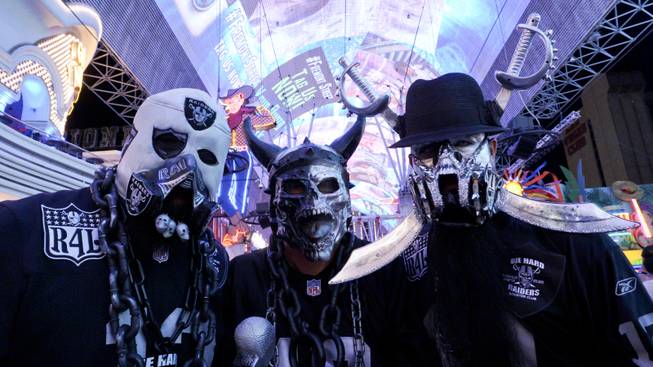
NFL Raiders fans were decked out in Raiders memorabilia for the Raider Nation hosted pub crawl in Downtown Las Vegas Friday, July 22, 2016.
Wednesday, July 27, 2016 | 2 a.m.
It is still far from clear whether Southern Nevada will become the home of a 65,000-seat stadium that could bring the Oakland Raiders to the area.
Numerous questions remain about the stadium project, which now has a price tag of $1.7 billion to $2.1 billion. Backers and tourism officials are still working through essential issues, including where the stadium would be built and how it would be funded.
Expect a little more clarity to emerge on Thursday, when the Southern Nevada Tourism Infrastructure Committee meets again at UNLV to continue evaluating the project. The special 11-member panel was supposed to wrap up its work by the end of this month, but Gov. Brian Sandoval recently extended the group’s deadline until the end of September.
Although there is not any obvious answer as to how the stadium debate will ultimately be resolved, there are some major questions that will need to be answered as discussions move forward (assuming they do). Here are five of them.
Where would the stadium be built?
Location is the most fundamental and pressing issue facing stadium backers, because the infrastructure committee needs a better sense of where the stadium might be located before it can finish discussing the funding for the project.
When Las Vegas Sands Corp. and Majestic Realty Co. initially came forward with the stadium plans, public conversations focused on one site owned by UNLV on Tropicana Avenue near Koval Lane. As concerns about the feasibility of that site arose, however, multiple other possibilities were introduced. Nine potential sites were discussed at the infrastructure committee’s last meeting two weeks ago.
Each of those sites presents different opportunities and challenges, which backers are expected to take into consideration as they evaluate the options in more detail. A preliminary site evaluation matrix indicated that backers would be looking at such issues as land costs, access and egress and parking as they weigh their options.
“It’s one thing to have a list of nine or 10 sites, and it’s another thing to have detail about those sites and be able to actually compare them and work them into the overall funding model for the stadium,” said Guy Hobbs, managing director of Hobbs, Ong & Associates and a member of the infrastructure committee’s technical advisory group.
Hobbs stressed two areas as being of major importance to the site considerations: the cost of land and associated infrastructure.
Among the possible stadium sites are MGM Resorts International’s festival grounds across Las Vegas Boulevard from SLS Las Vegas, Station Casinos’ land on Tropicana Avenue west of Interstate 15 and the Cashman Center. The Las Vegas City Council last week approved a motion to promote the viability of Cashman, so that could easily come up on Thursday. Mayor Carolyn Goodman sits on the infrastructure committee, and city manager Betsy Fretwell is part of its technical advisory group.
Committee Chairman Steve Hill, the executive director of the Governor’s Office of Economic Development, said he was expecting to make progress on the location issue at this week’s meeting. But Hill did not anticipate arriving at “a couple of final sites” until next month.
Clark County Commission Chairman Steve Sisolak, another committee member, said he was hoping to at least be able to soon discuss an “A Group” and a “B Group” of sites.
“We’ve got to somehow start narrowing this down,” Sisolak said.
How would it be funded?
This question has already received a lot of scrutiny because Sands and Majestic have asked for as much as $750 million in public funding, likely via county room taxes. Even though those taxes are paid largely by tourists, the huge dollar amount has been enough to trigger debate.
Developers say the public’s share of the stadium cost would remain fixed at $750 million while the private backers would be responsible for covering any cost overruns.
Still, an alternative funding plan that Hill introduced in June suggested slashing the public contribution to $550 million. The alternative was not received well by Sands, Majestic and the Raiders at the time, and the committee has yet to resume a substantive discussion of the conflicting proposals.
That’s because the group’s focus has shifted to the location question, which has direct bearing on the total cost of the stadium project. Hill said he planned to ask the developers to return in August with “a real response to what we put out a few meetings ago.”
What would the proposed tax district look like?
Room taxes are not the only financial issue that must be resolved for the project. Another lingering uncertainty is the specific nature of a proposed tax increment district, a mechanism through which the stadium's operators would receive certain tax revenue generated on — or potentially near — the premises.
Sands, Majestic and the infrastructure committee have yet to nail down the scope of the tax district. It could be drawn to only encompass the facility itself, for example, or it could also extend beyond that.
Sisolak has recently favored a larger tax district that would include development close to the stadium that arguably may not be built, or built to the same extent, otherwise. But the opportunity for an expanded tax district varies depending on the site: Some of the proposed sites offer a lot of room for additional development beyond a stadium, while others are more constrained in what else could be built there.
When would the governor call a special session?
If the infrastructure committee approves a legislative recommendation for the stadium project, the next step would be for Gov. Brian Sandoval to call a special session of the state Legislature.
Sandoval created the infrastructure committee last year via an executive order that requires the group to submit its recommendations to him. If it reaches agreement about the stadium project, the committee is likely to approve a legislative recommendation that would establish how to fund and oversee the facility. State lawmakers would consider that recommendation for approval.
But the Legislature isn’t scheduled to meet again until 2017, and stadium backers have indicated that they don’t want to wait that long to take the stadium deal to NFL owners.
So Sandoval could schedule a special session shortly after the committee concludes its work — which would put the session not long before the November election. The governor could also choose to schedule the session for after the election. It’s not clear yet which situation would be more likely.
Would the NFL allow the Raiders to relocate?
Should the project get through the infrastructure committee and the state Legislature, 24 of 32 NFL team owners would need to approve the Raiders’ relocation from Oakland to Las Vegas.
In previous years, that possibility would have seemed unlikely due to the league’s historical opposition to gambling. But multiple NFL owners have signaled that they're open to the idea of a team in Las Vegas.
Jerry Jones of the Dallas Cowboys, for example, has said “we don’t compromise the game … by being in Las Vegas or being near wagering,” according to the St. Louis Post-Dispatch. And Robert Kraft of the New England Patriots has said a team in Las Vegas “would be good for the NFL,” according to USA Today.


Join the Discussion:
Check this out for a full explanation of our conversion to the LiveFyre commenting system and instructions on how to sign up for an account.
Full comments policy